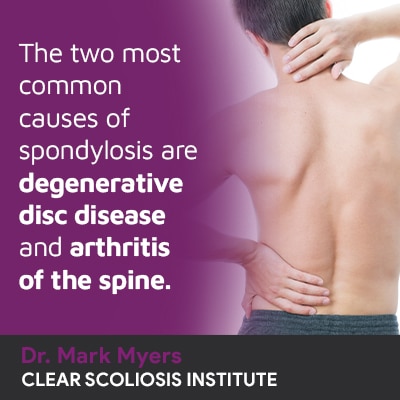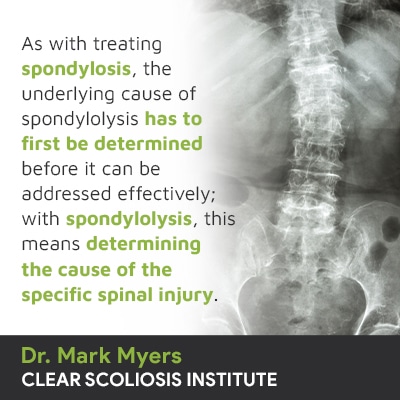
There is a natural amount of spinal degeneration that typically accompanies aging, but certain conditions and/or injuries can make those changes more severe and/or occur at faster rates. The spine can develop a number of conditions/issues such as spondylosis and spondylolysis, and while these two terms sound similar, they are not; continue reading to understand the difference.
The spine is a complex structure that, like the rest of the body, is subject to degenerative changes. Spondylosis refers to general spinal degeneration, often involving arthritis, and spondylolysis is commonly caused by an overuse injury involving a defect in the pars articularis between vertebrae.
As it’s helpful to have a basic understanding of spinal anatomy and function, let’s start by exploring the structure of a healthy spine.
A healthy spine is curved at each of its main sections, which includes the cervical spine (neck), thoracic spine (middle/upper back), and the lumbar spine (lower back).
The spine’s natural curves are what give it an ‘S’ shape when viewed from the sides, while it appears straight when viewed from the front and/or back.
The spine’s natural and healthy curves are a key part of its design; they make the spine stronger, more flexible, and better able to handle mechanical stress incurred during movement and daily activity.
If the spine loses a healthy curve, this disrupts the entire spine’s alignment and biomechanics.
Bones of the spine are called vertebrae, and in a healthy spine, they are aligned, meaning stacked on top of one another, and adjacent vertebrae are separated by an intervertebral disc.
Now, when it comes to spinal degeneration, and a number of other spinal conditions/issues, the spinal discs often play a role, and this is understandable in light of the many important roles they play in preserving the spine’s natural curves, alignment, and function: acting as the spine’s shock absorbers, preventing friction, facilitating flexible movement, and giving the spine structure as the vertebrae on either side of a disc attach to it.
So in order for the spine to function optimally, it needs to have its natural curves, alignment, and healthy intervertebral discs.
Now that we’ve covered some basic spinal anatomy, let’s move on to defining spondylosis.

Spondylosis doesn’t indicate where along the spine the changes have occurred, nor does it specify the cause of the degenerative changes.
The two most common causes of spondylosis are degenerative disc disease and arthritis of the spine.
Degenerative disc disease can be behind the development of many spinal conditions/issues and involves the deterioration of one or more of the spine’s intervertebral discs.
In most cases of spinal degeneration, it’s the spinal discs that are the first structures to start to deteriorate.
Intervertebral disc degeneration often involves a disc changing shape, losing height, and becoming desiccated; when a disc becomes dessicated, it loses all it's moisture, cushion, and shock absorption and ends up looking like a piece of dehydrated beef jerky, instead of a nice plump hydrated disc.
Discs are 80-percent water and 20-percent soft tissue. The more water you lose, the more height you lose, and over time, the spondylosis builds up; when this happens, it doesn’t just affect the disc itself, but also adjacent vertebrae and surrounding nerves.
When a disc degenerates and changes shape, its position can disrupt the spine’s natural alignment, and this impacts its curves, strength, function, and overall health.
When spondylosis is caused by arthritis of the spine, known as osteoarthritis, the cartilage that protects the ends of the vertebrae and facilitates the smooth gliding motion of the joints during movement has been eroded.
When there is a loss of cartilage, friction during movement will cause the vertebrae to deteriorate faster, and this type of excessive wear and tear tends to increase with age.
Women are also more vulnerable to osteoarthritis due to hormonal and bone-density changes caused by menopause.
To summarize, spondylosis is more of an umbrella term used to reference general spinal degeneration, and doesn’t indicate a specific cause or location within the spine; it’s commonly caused by degenerative disc disease or osteoarthritis.
As is the case with most spinal conditions, the first step towards effective treatment is determining a condition’s underlying cause; in cases of spondylosis, that means determining the cause behind the spinal degeneration.
Treatment plans have to be customized around a condition’s underlying cause, whether that be typical age-related spinal degeneration, arthritis of the spine, and/or intervertebral disc deterioration.
As a CLEAR-certified scoliosis chiropractor, I follow the CLEAR Scoliosis Institute treatment protocols which involve a conservative chiropractic-centered treatment approach.
When it comes to treating spondylosis, treatment plans are customized around a patient's condition characteristics, experienced symptoms, and involve combining chiropractic care and physical therapy.
Chiropractic care is condition-specific and can work towards manually adjusting the position of misaligned vertebrae, and this also impacts the nervous system as a misaligned vertebrae can compress its surrounding nerves.
Under the umbrella of chiropractic care, in addition to manual adjustments, a variety of strategies and therapies can be integrated such as guidance on how to lead a spine-friendly lifestyle, which can help with pain management, realigning the spine, and preventing further deterioration, at least for as long as possible.
When the spine is misaligned, it disrupts the biomechanics of the entire spine, so realigning the spine improves its overall strength and function, including the health of its intervertebral discs.
Using condition-specific chiropractic care can help increase the strength of the spine and its surroundings, which makes it less vulnerable to a crack/fracture.
Physical therapy involves specific exercises to rehydrate the disc material that are also condition-specific, and can help by increasing a patient’s core strength as this means the spine is supported by strong muscles, making it easier to maintain its natural curves and healthy alignment; this also helps improve disc health and function as increasing muscle strength means less pressure on the discs.
Now that we’ve defined spondylosis, and discussed how it can be treated effectively, let’s move on to defining spondylolysis.
One of the main differences between spondylosis and spondylolysis is that the former is more of a general term than a clinical diagnosis, while the latter refers to a specific defect where the vertebrae of the spine connect.
The lower back is the most vulnerable to the development of spondylolysis, and this is because the lumbar spine has to support the weight of the spinal sections above and the entire trunk.
The vertebrae of the lumbar spine also feel the effects of bending, lifting, and twisting motions, and the lumbar spine facilitates the coordination of lower-body movement (the hip, pelvis, legs, and feet).
In many cases, spondylolysis is caused by an overuse injury that introduces repeated stress to the lumbar spine, causing a vertebral stress fracture in the pars articularis.
Activities that involve the repetition of movements that strain the spine, such as excessive twisting (rotation of the spine), or repeated landing in extension (with back arched) in cases of gymnastics, can cause a crack and/or fracture in the pars, where the vertebral bodies meet; gymnastics, dancing, and football are some strenuous activities.
Generally, activities that involve repeatedly and excessively back bending can introduce adverse spinal tension, uneven pressure, cause faster rates of spinal degeneration, and make the spine more vulnerable to injury.

With a cracked or fractured pars, pain management and healing the affected vertebra(e) is key, and in those cases, when an overuse injury is to blame, lifestyle modification can involve stopping, modifying, or taking a break from the strenuous activity until the spine can heal.
Physical therapy is the focus of treatment and involves informing patients on what types of activities are safe for the spine, the use of certain condition-specific exercises and stretches for increasing core strength and spinal flexibility, while making sure the spine’s surrounding muscles are strong enough to support and stabilize it.
When appropriate, a back brace can help stabilize the spine while the injury heals, but this is only ideal for short periods of time as prolonged use can lead to weaker spinal muscles, which is more harmful in the long run.
A goal of spondylolysis treatment is to prevent further damage, such as the development of spondylolisthesis.
Spondylolisthesis injuries are graded between 1-5 depending on how far the vertebra slides forward on the vertebra below. When the vertebra slides less than 25% of the vertebral body below that is considered a Grade 1 or the least, 25-50% is a Grade II, 50-75% is a Grade 3, 75-100 is a Grade 4 and a Grade 5 is when the vertebra has slid all the way off the vertebral body below.
Grade 4’s and 5’s are typically surgical candidates. As Clear-certified doctors, we have successfully reduced Grades 1 & 2 and have been able to stabilize them to stop progression and further acceleration of the degenerative changes.
So the connection between spondylosis and spondylolysis is that, as general spinal degeneration, if spondylosis is left untreated, it can become spondylolysis as the spine is more vulnerable to injury; the main difference is that the former is a general term indicating spinal degeneration, and the latter is referencing a specific crack or fracture that’s caused by a structural abnormality within the pars, where vertebrae connect.
Also, spondylosis tends to affect older adults as it involves age-related spinal degeneration, and spondylolysis is more commonly diagnosed in adolescents who are active in certain sports/activities that repeatedly strain the lumbar spine.
Once a spine has started to degenerate, it’s less stable, making it more vulnerable to injury, and this also makes the spine more likely to develop additional spinal conditions/issues in the future.
So when it comes to spondylosis and spondylolysis, we’re talking about a general term referencing spinal degeneration with varying causes, versus a spinal condition that involves a specific crack or fracture within the pars, where vertebrae connect.
The spinal degeneration that spondylosis is referencing can be natural and age-related, or excessive due to the presence of another spinal condition such as osteoporosis or degenerative disc disease.
With spondylolysis, the type of injury capable of cracking or fracturing a pars is what’s known as an overuse injury, and this commonly involves repeatedly straining the lower back.
If spondylosis, as general spinal degeneration, is left untreated, it can destabilize the spine to the point that it becomes more vulnerable to injury and spondylolysis can occur.
Here at the CLEAR Scoliosis Institute, we are proactive with treatment in an effort to preserve spinal strength and function, while preventing further damage and the development of additional spinal conditions/issues in the future.
So don't lose heart if you are someone who already has spondylosis; the sooner you take proactive action, the sooner you can stop the degenerative process and start working to reverse some of the damage that has been built up over time.
As the saying goes, the best time to plant a tree is 20 years ago; the next best time is now.

CLEAR provides a unique and innovative way of understanding scoliosis. Sign up to receive facts and information you won’t find anywhere else.
